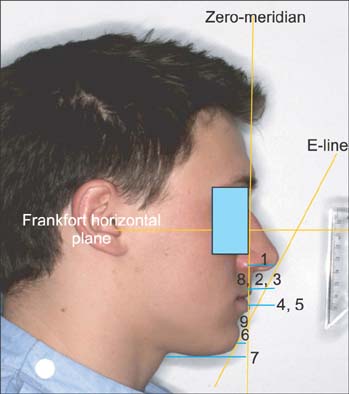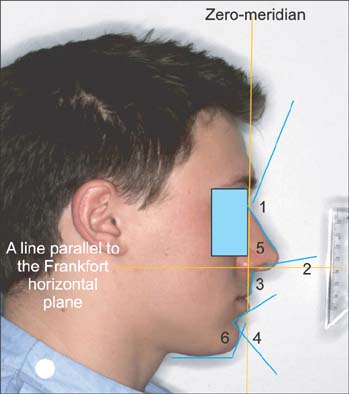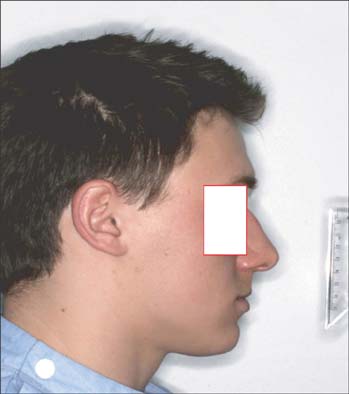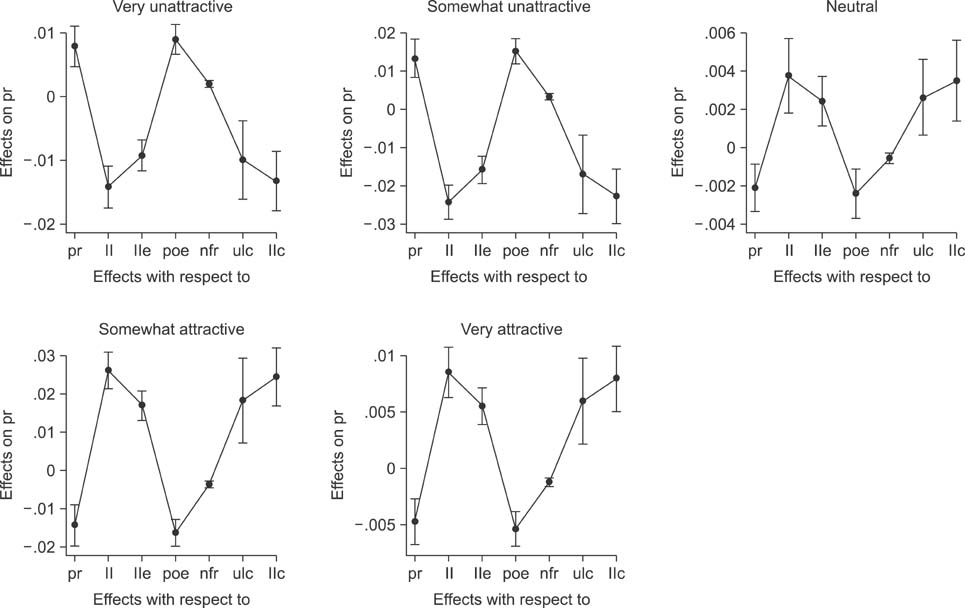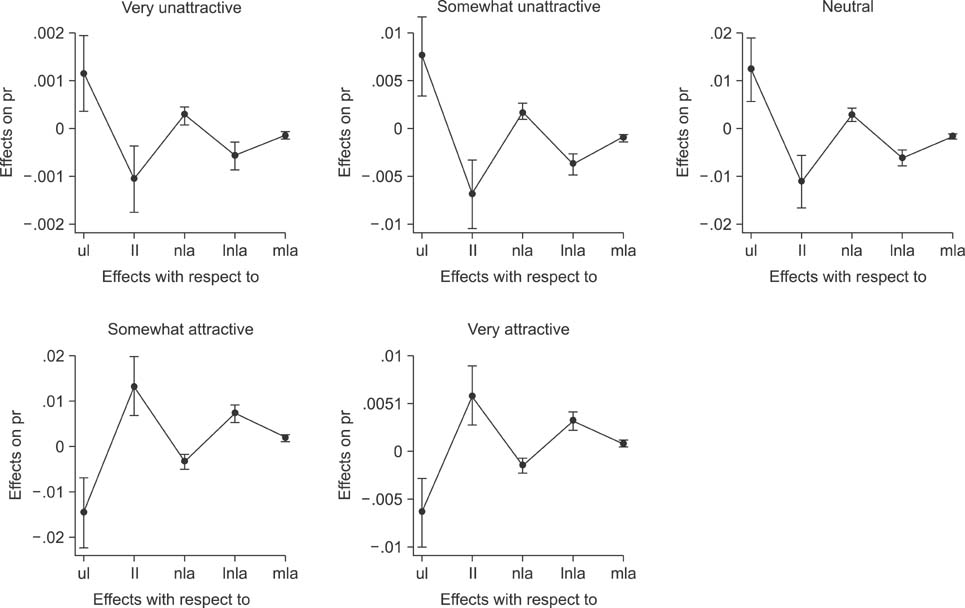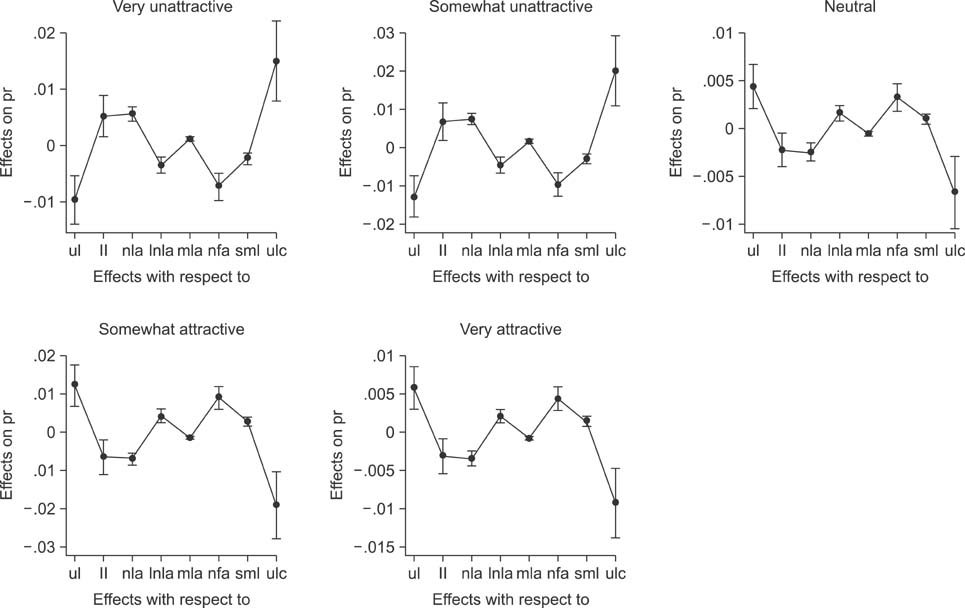Facial profile parameters and their relative influence on bilabial prominence and the perceptions of facial profile attractiveness: A novel approach
- Affiliations
-
- 1Department of Orthodontics, St. George's Hospital and King's College London Dental Institute, London, UK.
- 2Department of Orthodontics, King's College London Dental Institute, London, UK.
- 3Department of Biostatistics, Oral and Dental Sciences, University of Bristol, Bristol, UK.
- 4Department of Orthodontics, Kingston and St. George's Hospitals and St. George's Medical School, London, UK. Farhad.Naini@yahoo.co.uk
- KMID: 2273275
- DOI: http://doi.org/10.4041/kjod.2014.44.4.184
Abstract
OBJECTIVE
To evaluate the relative importance of bilabial prominence in relation to other facial profile parameters in a normal population.
METHODS
Profile stimulus images of 38 individuals (28 female and 10 male; ages 19-25 years) were shown to an unrelated group of first-year students (n = 42; ages 18-24 years). The images were individually viewed on a 17-inch monitor. The observers received standardized instructions before viewing. A six-question questionnaire was completed using a Likert-type scale. The responses were analyzed by ordered logistic regression to identify associations between profile characteristics and observer preferences. The Bayesian Information Criterion was used to select variables that explained observer preferences most accurately.
RESULTS
Nasal, bilabial, and chin prominences; the nasofrontal angle; and lip curls had the greatest effect on overall profile attractiveness perceptions. The lip-chin-throat angle and upper lip curl had the greatest effect on forehead prominence perceptions. The bilabial prominence, nasolabial angle (particularly the lower component), and mentolabial angle had the greatest effect on nasal prominence perceptions. The bilabial prominence, nasolabial angle, chin prominence, and submental length had the greatest effect on lip prominence perceptions. The bilabial prominence, nasolabial angle, mentolabial angle, and submental length had the greatest effect on chin prominence perceptions.
CONCLUSIONS
More prominent lips, within normal limits, may be considered more attractive in the profile view. Profile parameters have a greater influence on their neighboring aesthetic units but indirectly influence related profile parameters, endorsing the importance of achieving an aesthetic balance between relative prominences of all aesthetic units of the facial profile.
Keyword
Figure
Cited by 4 articles
-
Evaluation of the facial dimensions of young adult women with a preferred facial appearance
Sae Yong Kim, Mohamed Bayome, Jae Hyun Park, Yoon-Ah Kook, Ju Hee Kang, Kang Hyuk Kim, Hong-Beom Moon
Korean J Orthod. 2015;45(5):253-260. doi: 10.4041/kjod.2015.45.5.253.The influence of age on lip-line cant in adults: a cross-sectional study
Sung Hwan Choi, Jung Suk Kim, Cheol Soon Kim, Chung Ju Hwang
Korean J Orthod. 2016;46(2):81-86. doi: 10.4041/kjod.2016.46.2.81.Effect of frontal facial type and sex on preferred chin projection
Jin-Young Choi, Taeyun Kim, Hyung-Mo Kim, Sang-Hoon Lee, Il-sik Cho, Seung-Hak Baek
Korean J Orthod. 2017;47(2):108-117. doi: 10.4041/kjod.2017.47.2.108.Disparity in opinions on lip protrusiveness in contemporary African American faces
Yvette Battle, Monica Schneider, Laurence Magder, Eung-Kwon Pae
Korean J Orthod. 2018;48(1):23-29. doi: 10.4041/kjod.2018.48.1.23.
Reference
-
1. Auger TA, Turley PK. The female soft tissue profile as presented in fashion magazines during the 1900s: a photographic analysis. Int J Adult Orthodon Orthognath Surg. 1999; 14:7–18.2. Nguyen DD, Turley PK. Changes in the Caucasian male facial profile as depicted in fashion magazines during the twentieth century. Am J Orthod Dentofacial Orthop. 1998; 114:208–217.
Article3. Mamandras AH. Growth of lips in two dimensions: a serial cephalometric study. Am J Orthod. 1984; 86:61–66.
Article4. Mamandras AH. Linear changes of the maxillary and mandibular lips. Am J Orthod Dentofacial Orthop. 1988; 94:405–410.
Article5. Bhatia SN, Leighton BC. A manual of facial growth: a computer analysis of longitudinal cephalometric growth data. Oxford: Oxford University Press;1993.6. Yehezkel S, Turley PK. Changes in the African American female profile as depicted in fashion magazines during the 20th century. Am J Orthod Dentofacial Orthop. 2004; 125:407–417.
Article7. Prahl-Andersen B, Boersma H, van der Linden FP, Moore AW. Perceptions of dentofacial morphology by laypersons, general dentists, and orthodontists. J Am Dent Assoc. 1979; 98:209–212.
Article8. Kerr WJ, O'Donnell JM. Panel perception of facial attractiveness. Br J Orthod. 1990; 17:299–304.
Article9. Bell R, Kiyak HA, Joondeph DR, McNeill RW, Wallen TR. Perceptions of facial profile and their influence on the decision to undergo orthognathic surgery. Am J Orthod. 1985; 88:323–332.
Article10. Foster EJ. Profile preferences among diversified groups. Angle Orthod. 1973; 43:34–40.11. Hall D, Taylor RW, Jacobson A, Sadowsky PL, Bartolucci A. The perception of optimal profile in African Americans versus white Americans as assessed by orthodontists and the lay public. Am J Orthod Dentofacial Orthop. 2000; 118:514–525.
Article12. Naini FB. Facial aesthetics: concepts and clinical diagnosis. Oxford: Wiley-Blackwell;2011.13. Ricketts RM. A foundation for cephalometric communication. Am J Orthod. 1960; 46:330–357.
Article14. Ricketts RM. The value of cephalometrics and computerized technology. Angle Orthod. 1972; 42:179–199.15. Steiner CC. Cephalometrics for you and me. Am J Orthod. 1953; 39:729–755.
Article16. Steiner CC. Cephalometrics in clinical practice. Angle Orthod. 1959; 29:8–29.17. Merrifield LL. The profile line as an aid in critically evaluating facial esthetics. Am J Orthod. 1966; 52:804–822.
Article18. Holdaway RA. A soft-tissue cephalometric analysis and its use in orthodontic treatment planning. Part I. Am J Orthod. 1983; 84:1–28.
Article19. Holdaway RA. A soft-tissue cephalometric analysis and its use in orthodontic treatment planning. Part II. Am J Orthod. 1984; 85:279–293.
Article20. Burstone CJ. Lip posture and its significance in treatment planning. Am J Orthod. 1967; 53:262–284.
Article21. Burstone CJ, James RB, Legan H, Murphy GA, Norton LA. Cephalometrics for orthognathic surgery. J Oral Surg. 1978; 36:269–277.22. Riedel RR. An analysis of dentofacial relationships. Am J Orthod. 1957; 43:103–119.
Article23. Bender R, Grouven U. Ordinal logistic regression in medical research. J R Coll Physicians Lond. 1997; 31:546–551.24. Weakliem DL. A critique of the bayesian information criterion for model selection. Soc Methods Res. 1999; 27:359–357.
Article
- Full Text Links
- Actions
-
Cited
- CITED
-
- Close
- Share
- Similar articles
-
- The influence of gender or culture on determining esthetic facial profile
- The effects of maxillary incisor positions and chin prominences on the perception of lateral smiling profile attractiveness among orthodontists and laypersons
- The Perception of Facial Profile in Korean
- A study of esthetic facial profile preference in Korean
- Evaluation of Influence of Individual Facial Aesthetic Subunits on the Congnition of Facial Attractiveness in Public

